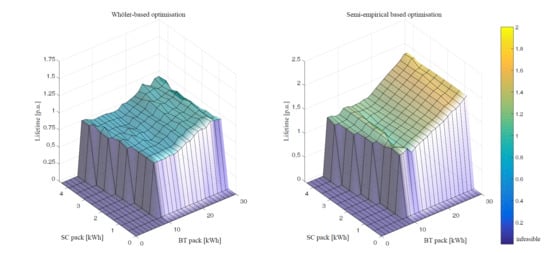Li-Ion Battery Lifetime Model’s Influence on the Economic Assessment of a Hybrid Electric Bus’s Operation
Abstract
:1. Introduction
2. Scenario Overview
3. Modelling of the Onboard Dual ESS
3.1. Electrical Modelling
3.2. Lifetime Modelling
3.2.1. Wöhler-Curve-Based Lifetime Model
3.2.2. Semi-Empirical Lifetime Model
4. Rule-Based Energy Management Strategy
4.1. Hybrid Driving Mode
- the genset power target.
- (kW) the BT power target during discharge.
- the BT power target during charge.
- the nominal voltage of the BT cell.
- the nominal current of the BT cell.
- the C-rate limitation for the BT operation.
- the ratio for BT pack discharging () with different values for DM, SM, and Electric Mode (EM).
- the ratio for charging the BT pack ().
- the energy dissipated in the crowbar.
- is the maximum allowable power target for charging the SC pack (maximum power of the DC/DC).
- is the energy provided/stored in the BT pack during a traction and braking phase.
- is the energy provided/stored in the SC pack during a traction and braking phase.
- is the energy dissipated in the crowbar.
- is the energy provided by the genset.
- is the energy provided by the genset to charge the BT pack.
4.2. Full-Electric Driving Mode
5. Multi-Objective Optimisation Problem
Operation Cost of the Dual ESS
6. Results and Discussion
7. Conclusions
Author Contributions
Funding
Conflicts of Interest
References
- Hu, X.; Johannesson, L.; Murgovski, N.; Egardt, B. Longevity-conscious dimensioning and power management of the hybrid energy storage system in a fuel cell hybrid electric bus. Appl. Energy 2015, 137, 913–924. [Google Scholar] [CrossRef]
- Luo, X.; Wang, J.; Dooner, M.; Clarke, J. Overview of current development in electrical energy storage technologies and the application potential in power system operation. Appl. Energy 2015, 137, 511–536. [Google Scholar] [CrossRef]
- Dimitrova, Z.; Maréchal, F. Techno-economic design of hybrid electric vehicles and possibilities of the multi-objective optimization structure. Appl. Energy 2016, 161, 746–759. [Google Scholar] [CrossRef]
- Shen, J.; Dusmez, S.; Khaligh, A. Optimization of Sizing and Battery Cycle Life in Battery/Ultracapacitor Hybrid Energy Storage Systems for Electric Vehicle Applications. IEEE Trans. Ind. Inform. 2014, 10, 2112–2121. [Google Scholar] [CrossRef]
- Masih-Tehrani, M.; Ha’iri-Yazdi, M.R.; Esfahanian, V.; Safaei, A. Optimum sizing and optimum energy management of a hybrid energy storage system for lithium battery life improvement. J. Power Sources 2013, 244, 2–10. [Google Scholar] [CrossRef]
- Song, Z.; Li, J.; Han, X.; Xu, L.; Lu, L.; Ouyang, M. Multi-objective optimization of a semi-active battery/supercapacitor energy storage system for electric vehicles. Appl. Energy 2014, 153, 212–224. [Google Scholar] [CrossRef]
- Xi, J.; Li, M.; Xu, M. Optimal energy management strategy for battery powered electric vehicles. Appl. Energy 2014, 134, 332–341. [Google Scholar] [CrossRef]
- Hu, X.; Murgovski, N.; Johannesson, L.; Egardt, B. Energy efficiency analysis of a series plug-in hybrid electric bus with different energy management strategies and battery sizes. Appl. Energy 2013, 111, 1001–1009. [Google Scholar] [CrossRef]
- Zakeri, B.; Syri, S. Electrical energy storage systems: A comparative life cycle cost analysis. Renew. Sustain. Energy Rev. 2015, 42, 569–596. [Google Scholar] [CrossRef]
- Fuchs, G.; Lunz, B.; Leuthold, M.; Sauer, D.U. Technology Overview on Electricity Storage; ISEA: Aachen, Germany, 2012. [Google Scholar]
- Barré, A.; Deguilhem, B.; Grolleau, S.; Gérard, M.; Suard, F.; Riu, D. A review on lithium-ion battery ageing mechanisms and estimations for automotive applications. J. Power Sources 2013, 241, 680–689. [Google Scholar] [CrossRef]
- Dufo-López, R. Optimisation of size and control of grid-connected storage under real time electricity pricing conditions. Appl. Energy 2015, 140, 395–408. [Google Scholar] [CrossRef]
- Pavković, D.; Hoić, M.; Deur, J.; Petrić, J. Energy storage systems sizing study for a high-altitude wind energy application. Energy 2014, 76, 91–103. [Google Scholar] [CrossRef]
- Aichhorn, A.; Greenleaf, M.; Li, H.; Zheng, J. A cost effective battery sizing strategy based on a detailed battery lifetime model and an economic energy management strategy. In Proceedings of the 2012 IEEE Power and Energy Society General Meeting, San Diego, CA, USA, 22–26 July 2012; pp. 1–8. [Google Scholar] [CrossRef]
- Herrera, V.; Milo, A.; Gaztañaga, H.; Etxeberria-Otadui, I.; Villarreal, I.; Camblong, H. Adaptive energy management strategy and optimal sizing applied on a battery-supercapacitor based tramway. Appl. Energy 2016, 169, 831–845. [Google Scholar] [CrossRef]
- Sarasketa-Zabala, E.; Martinez-Laserna, E.; Berecibar, M.; Gandiaga, I.; Rodriguez-Martinez, L.M.; Villarreal, I. Realistic lifetime prediction approach for Li-ion batteries. Appl. Energy 2016, 162, 839–852. [Google Scholar] [CrossRef]
- Herrera, V.I.; Saez-de-Ibarra, A.; Milo, A.; Gaztañaga, H.; Camblong, H. Optimal energy management of a hybrid electric bus with a battery-supercapacitor storage system using genetic algorithm. In Proceedings of the 2015 International Conference on Electrical Systems for Aircraft, Railway, Ship Propulsion and Road Vehicles (ESARS), Aachen, Germany, 3–5 March 2015; pp. 1–6. [Google Scholar]
- Sarasketa-Zabala, E.; Gandiaga, I.; Martinez-Laserna, E.; Rodriguez-Martinez, L.M.; Villarreal, I. Cycle ageing analysis of a LiFePO4/graphite cell with dynamic model validations: Towards realistic lifetime predictions. J. Power Sources 2015, 275, 573–587. [Google Scholar] [CrossRef]
- Facinelli, W.A. Modeling and Simulation of Lead-Acid Batteries for Photovoltaic Systems. Ph.D. Thesis, Arizona State University, Tempe, AZ, USA, 1983. [Google Scholar]
- Sauer, D.U.; Wenzl, H. Comparison of different approaches for lifetime prediction of electrochemical systems—Using lead-acid batteries as example. J. Power Sources 2008, 176, 534–546. [Google Scholar] [CrossRef]
- Sarasketa-Zabala, E. A Novel Approach for Lithium-Ion Battery Selection and Lifetime Prediction. Ph.D. Thesis, Mondragon University, Mondragón, Spain, 2014. Ik4-Ikerlan. [Google Scholar]
- Sarasketa-Zabala, E.; Gandiaga, I.; Rodriguez-Martinez, L.M.; Villarreal, I. Calendar ageing analysis of a LiFePO4/graphite cell with dynamic model validations: Towards realistic lifetime predictions. J. Power Sources 2014, 272, 45–57. [Google Scholar] [CrossRef]
- Herrera, V.I.; Milo, A.; Gaztañaga, H.; Camblong, H. Multi-Objective Optimization of Energy Management and Sizing for a Hybrid Bus with Dual Energy Storage System. In Proceedings of the 2016 IEEE Vehicle Power and Propulsion Conference (VPPC), Hangzhou, China, 17–20 October 2016; pp. 1–6. [Google Scholar]
- MathWorks. Fuzzy Logic Toolbox User’s Guide R2017a; The MathWorks, Inc.: Natick, MA, USA, 2017. [Google Scholar]
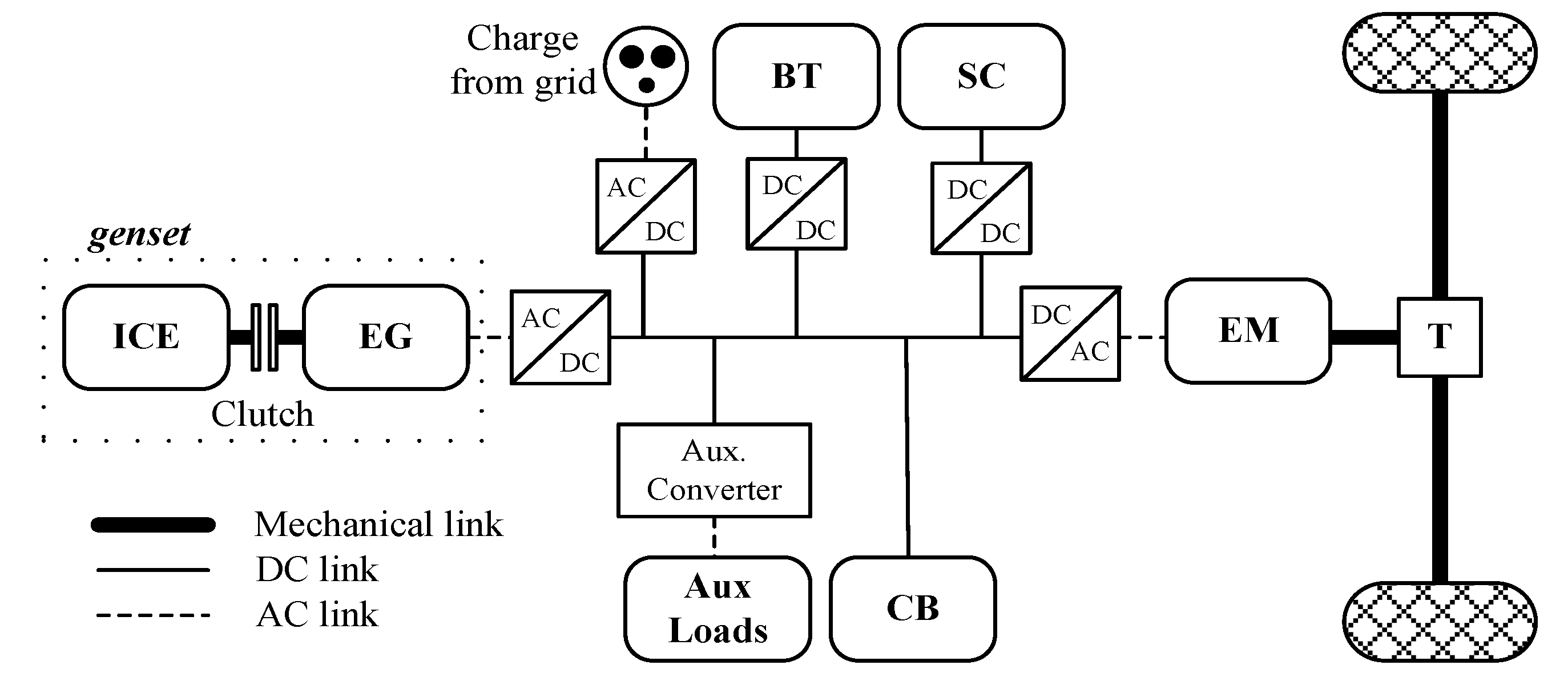

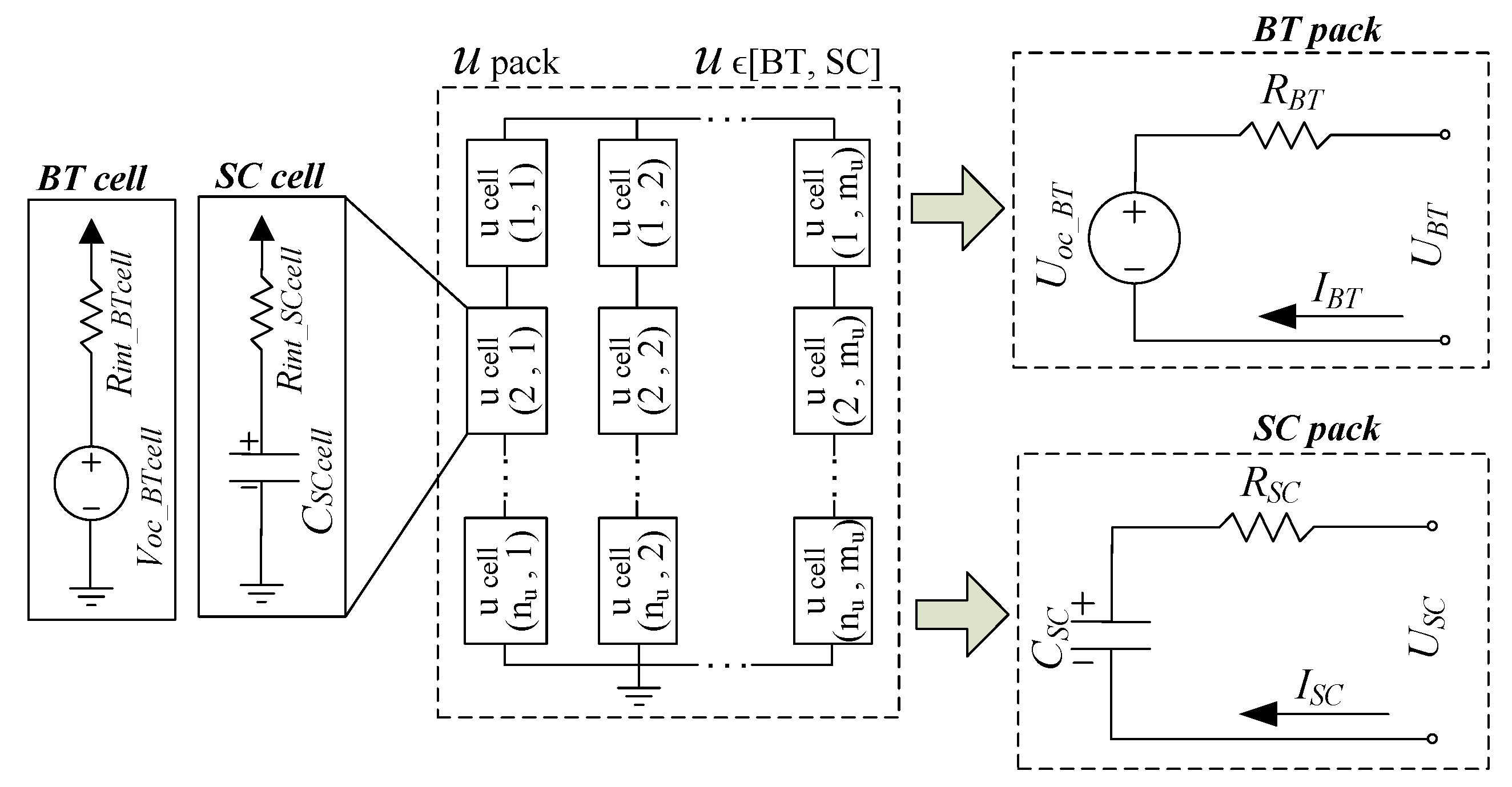
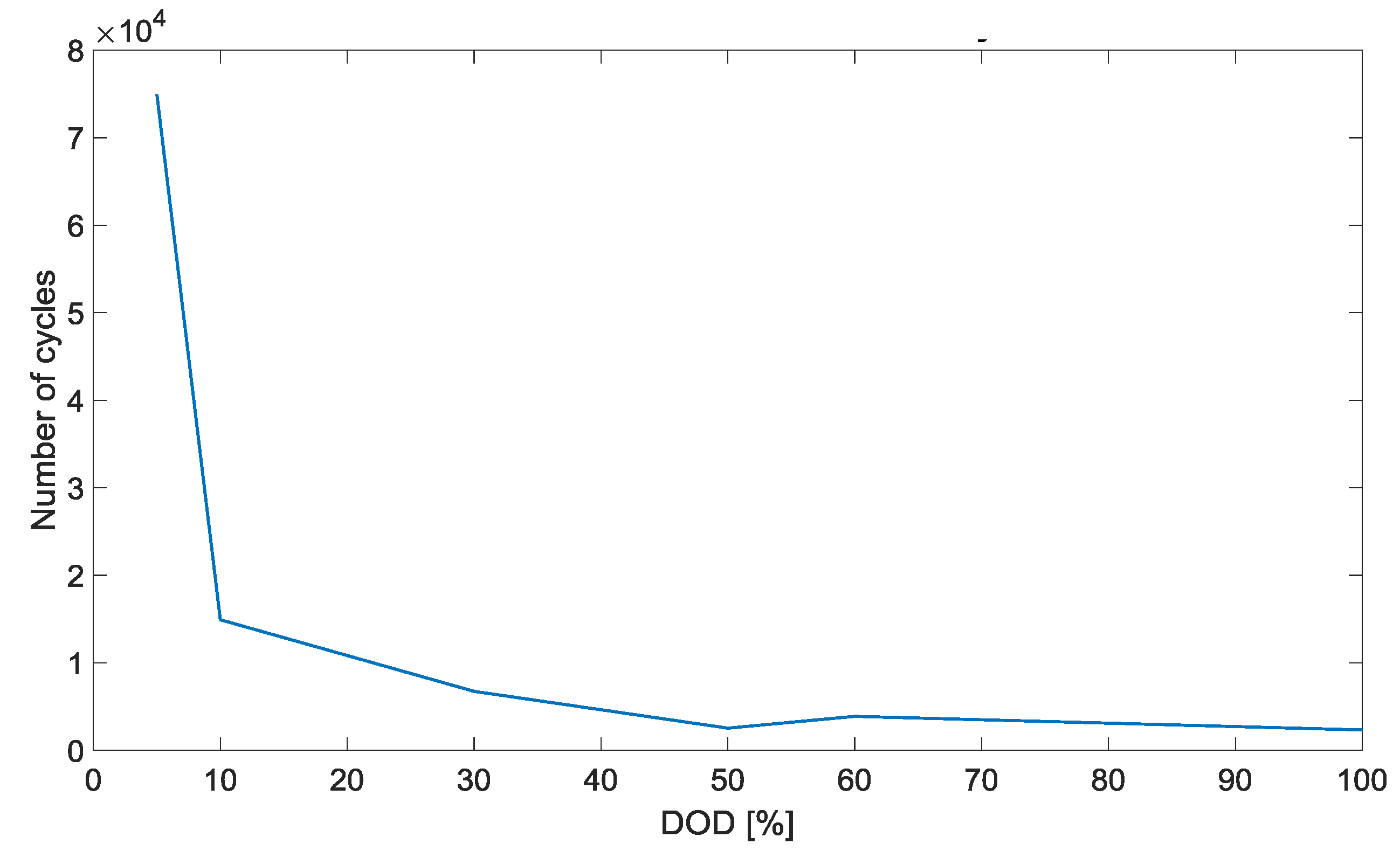
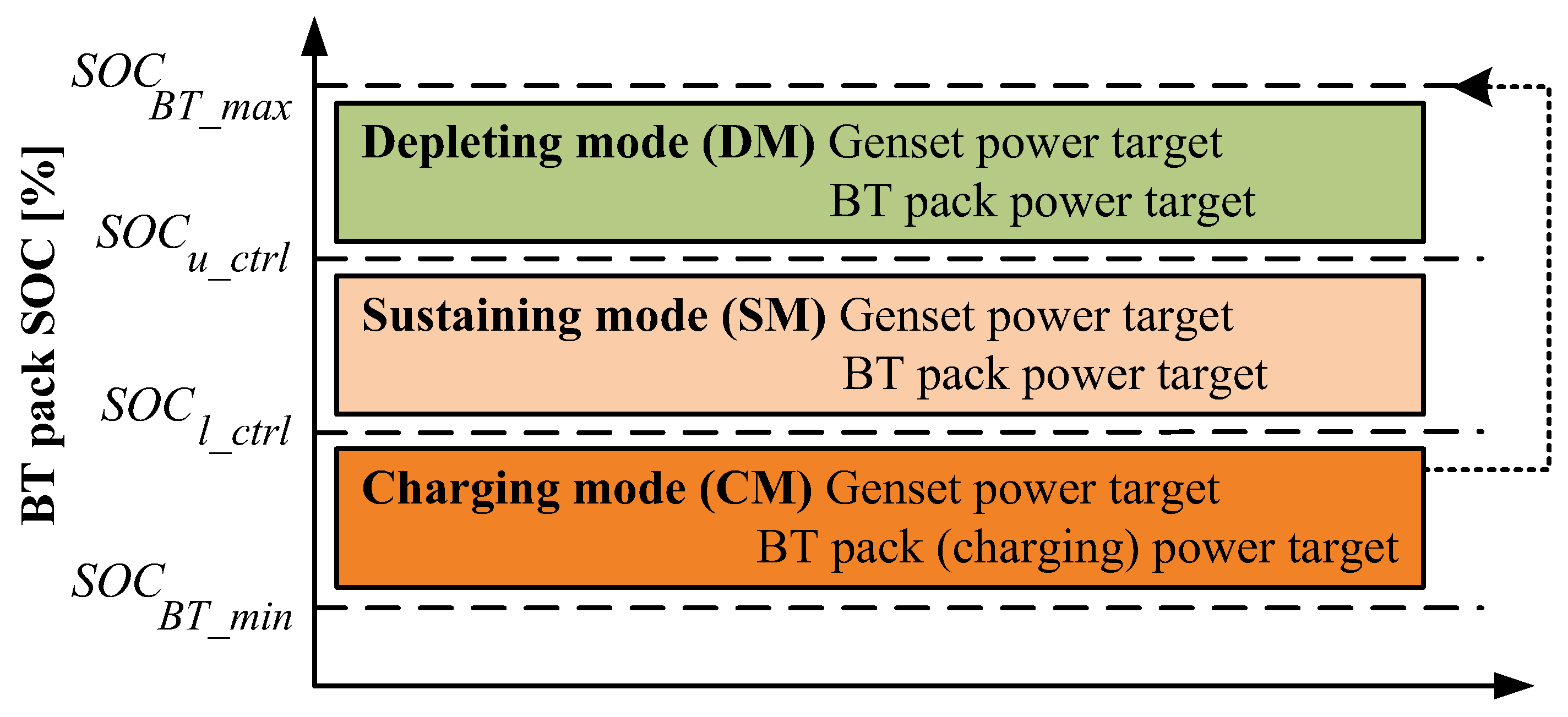
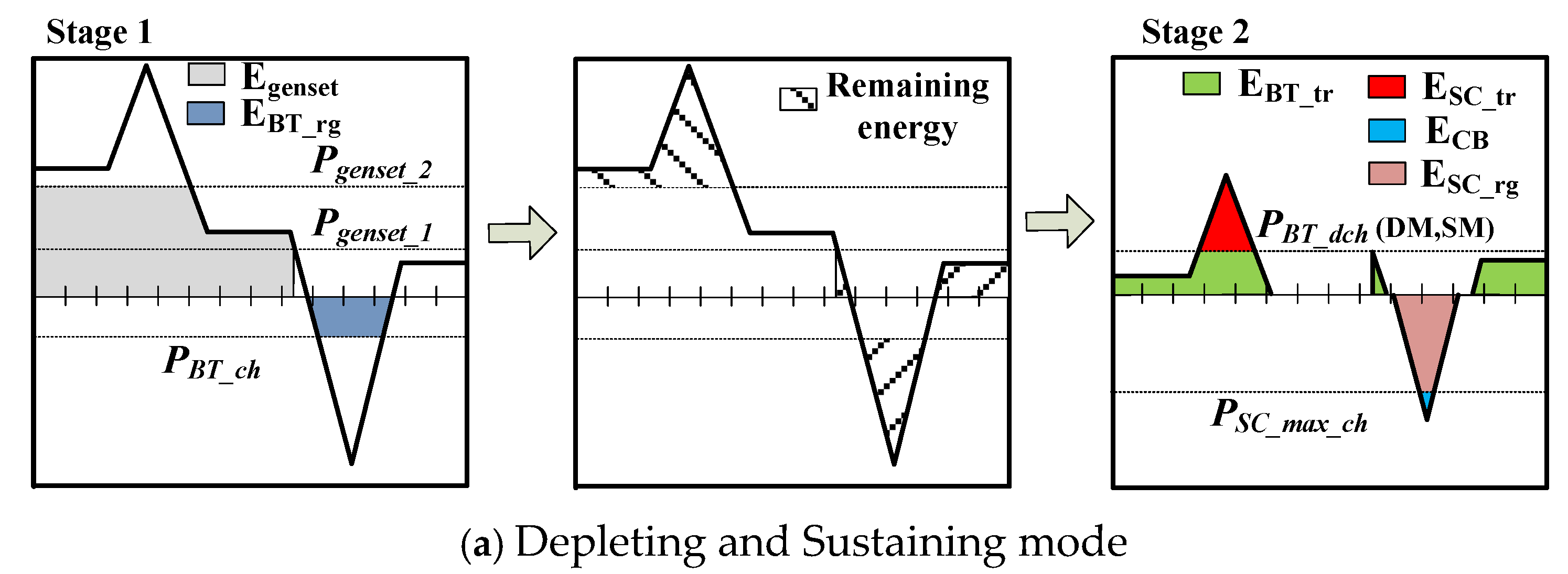
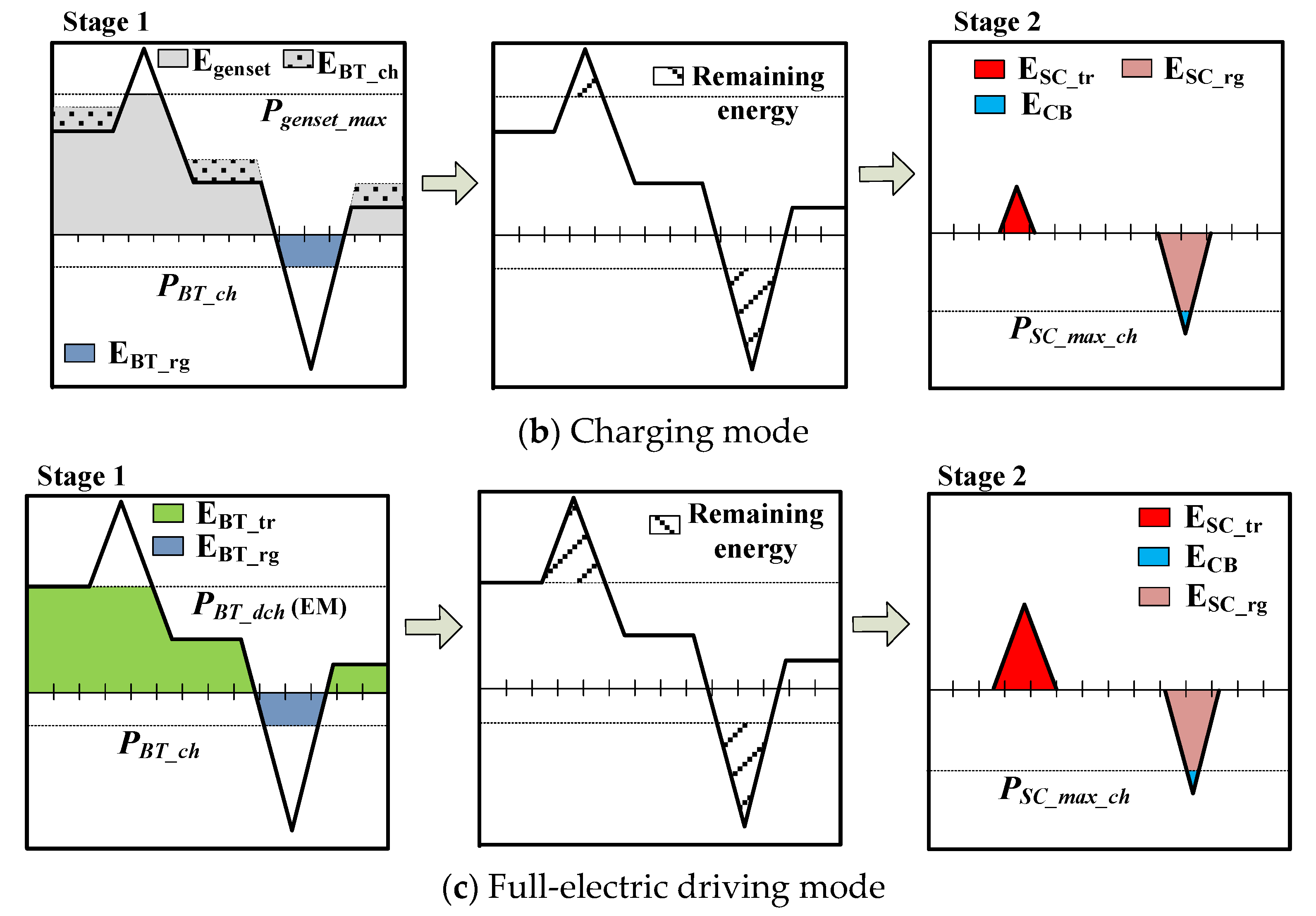
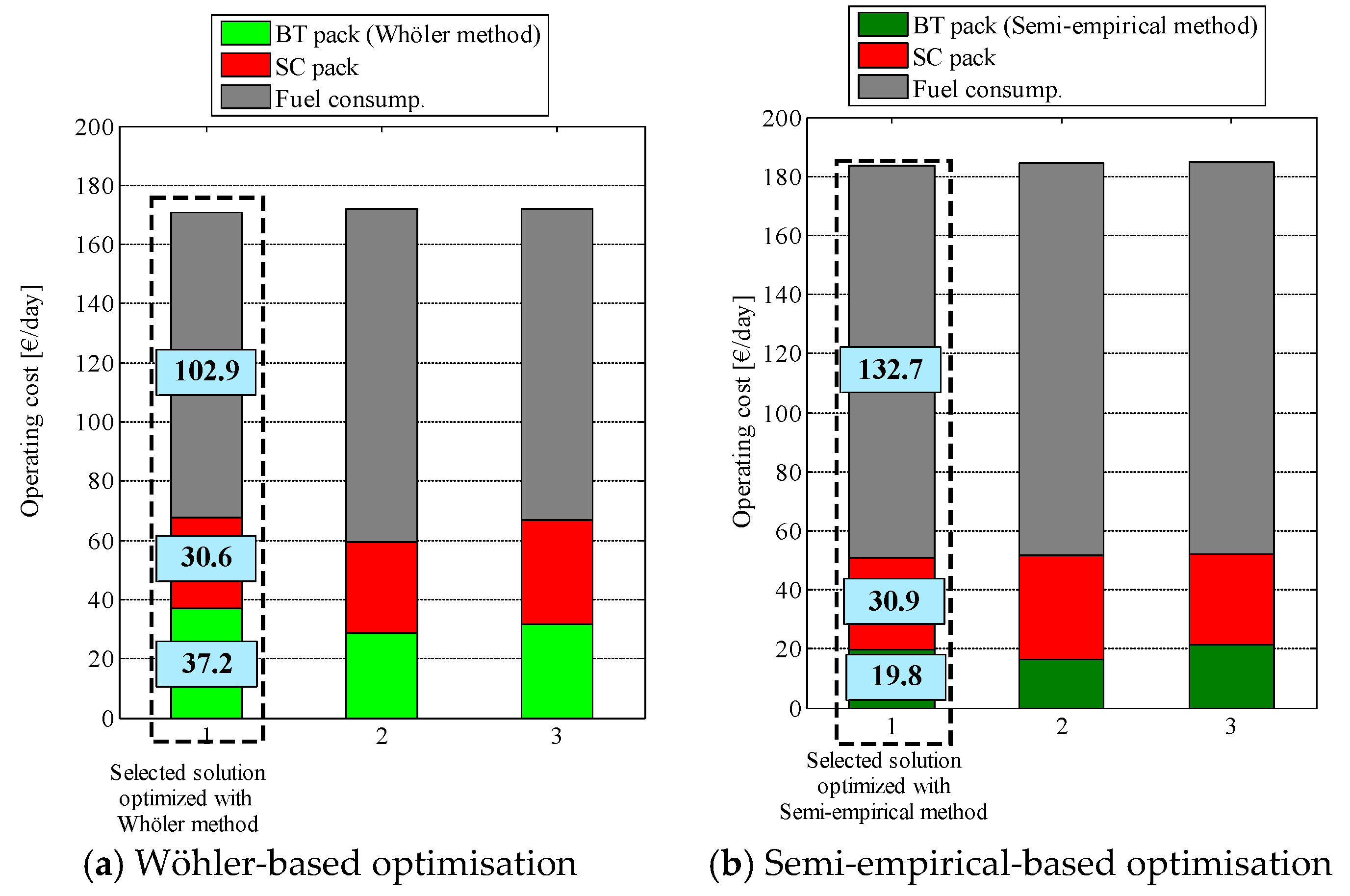
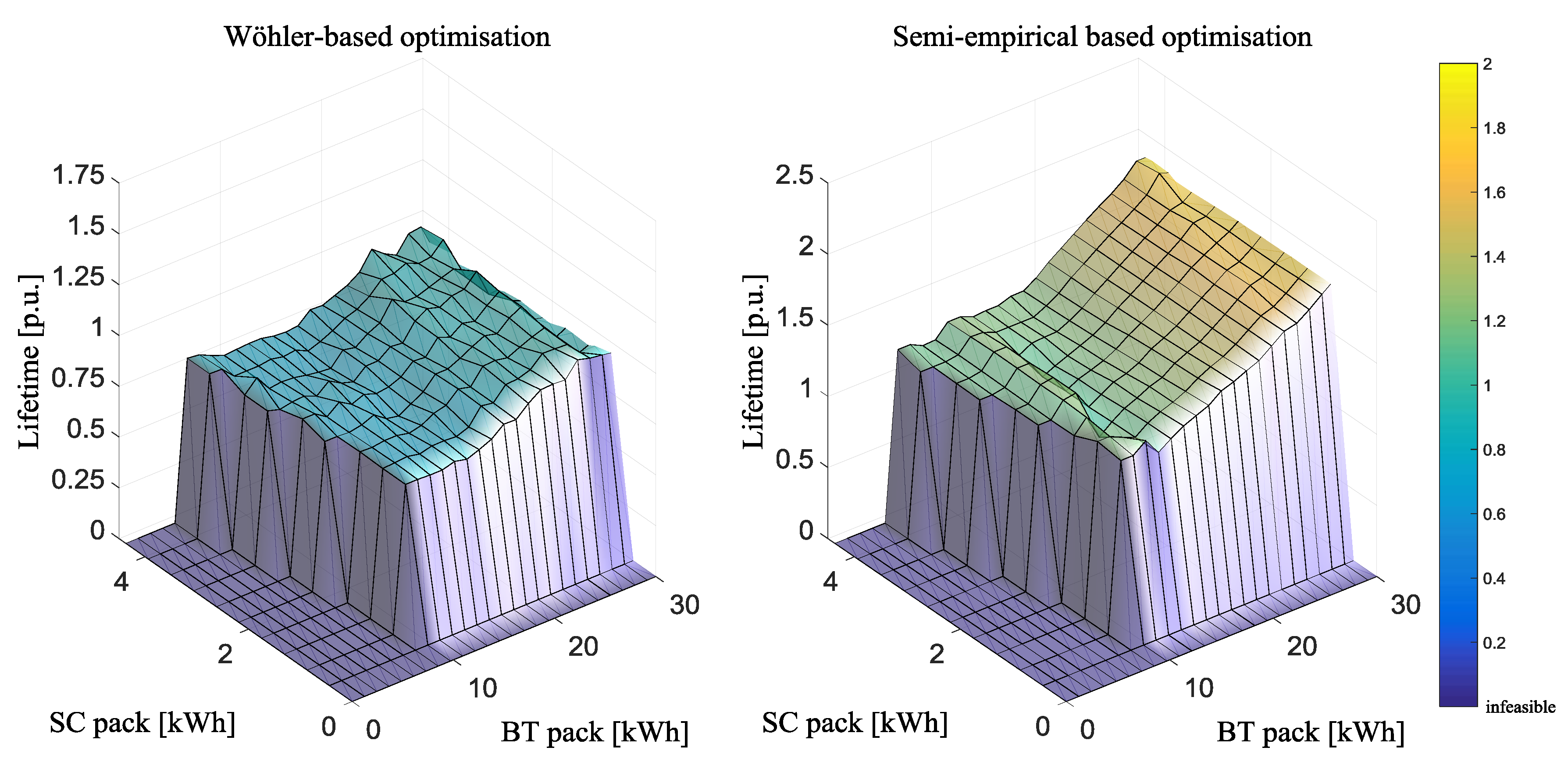
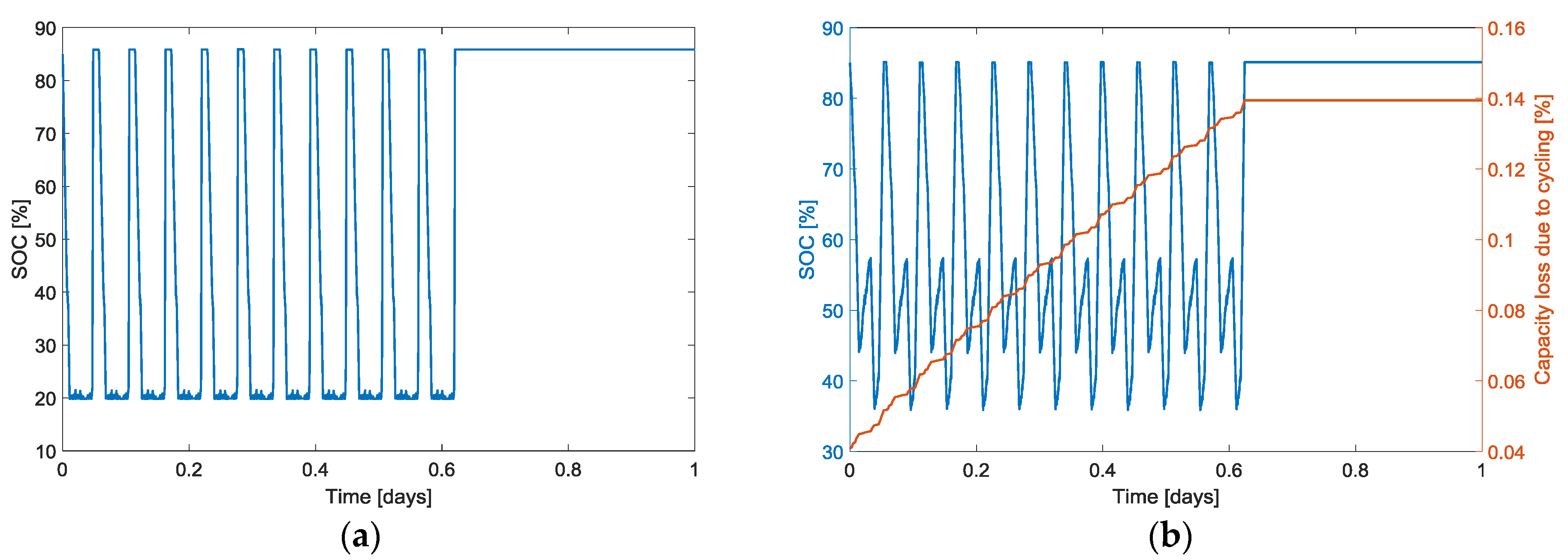
| BT (LFP 2.3Ah 26650-Type) | SC (BCAP3000) | ||
|---|---|---|---|
| Nominal voltage | 3.3 V | Nominal voltage | 2.7 V |
| Nominal capacity | 2.3 Ah | Nominal capacitance | 3000 F |
| DC internal resistance | Ω | DC internal resistance | 0.29 mΩ |
| Max C rate disch./ch. | 3.5/3.5 | - | - |
| Gravimetric Energy Density | 108 Wh/kg | Gravimetric Energy Density | 6.0 Wh/kg |
| Number of cells in series (pack) | 182 | Number of cells in series (pack) | 144 |
| DC/DC converter rating | 50 kW | DC/DC converter rating | 150 kW |
| Variable | Wöhler-Based Optimisation | Semi-Empirical-Based Optimisation |
|---|---|---|
| (%) | 66 | 93 |
| (%) | 39 | 44 |
| (kW) | 53 | 63 |
| (kW) | 83 | 124 |
| (kW) | 78 | 71 |
| (kW) | 81 | 25 |
| (kW) | 21 | 30 |
| (kW) | 81 | 77 |
| (-) | 12 | 10 |
| (-) | 2 | 2 |
© 2018 by the authors. Licensee MDPI, Basel, Switzerland. This article is an open access article distributed under the terms and conditions of the Creative Commons Attribution (CC BY) license (http://creativecommons.org/licenses/by/4.0/).
Share and Cite
Martinez-Laserna, E.; Herrera, V.I.; Gandiaga, I.; Milo, A.; Sarasketa-Zabala, E.; Gaztañaga, H. Li-Ion Battery Lifetime Model’s Influence on the Economic Assessment of a Hybrid Electric Bus’s Operation. World Electr. Veh. J. 2018, 9, 28. https://doi.org/10.3390/wevj9020028
Martinez-Laserna E, Herrera VI, Gandiaga I, Milo A, Sarasketa-Zabala E, Gaztañaga H. Li-Ion Battery Lifetime Model’s Influence on the Economic Assessment of a Hybrid Electric Bus’s Operation. World Electric Vehicle Journal. 2018; 9(2):28. https://doi.org/10.3390/wevj9020028
Chicago/Turabian StyleMartinez-Laserna, Egoitz, Victor I. Herrera, Iñigo Gandiaga, Aitor Milo, Elixabet Sarasketa-Zabala, and Haizea Gaztañaga. 2018. "Li-Ion Battery Lifetime Model’s Influence on the Economic Assessment of a Hybrid Electric Bus’s Operation" World Electric Vehicle Journal 9, no. 2: 28. https://doi.org/10.3390/wevj9020028
APA StyleMartinez-Laserna, E., Herrera, V. I., Gandiaga, I., Milo, A., Sarasketa-Zabala, E., & Gaztañaga, H. (2018). Li-Ion Battery Lifetime Model’s Influence on the Economic Assessment of a Hybrid Electric Bus’s Operation. World Electric Vehicle Journal, 9(2), 28. https://doi.org/10.3390/wevj9020028




